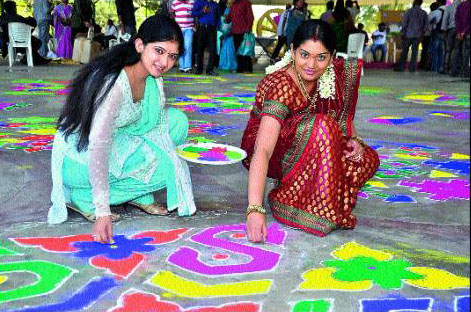
Mangalore, January 14: In the Hindu calendar the movements of the planets plays an important role in our daily life. The significance of the Sun is one of the most important factors during the month of January. The Sun is continuously changing its position and even though it is the centre of our solar system, its position during the first half of the year is called “Uttarayana” and during the second half of the year it is called “Dakshinayana”. So, the event of the sun changing its position from one rashi to another is called 'Sankranthi'.
This is the festivity which is celebrated on January 14 and is called with different names 'Makara Sankramana' or ' Makara Sankranthi'. It symbolises the gradual movement of the sun from one 'rashi' to another. On Sankranthi day the sun's phase changes from Chandramana to Souramana. During the Souramana phase the months 'Mesha' slowly changes over till 'Meena'. Thus the first phase of the year which is called 'Uttarayana' begins. The auspicious day of Sankranthi marks the beginning of Uttarayana. During this punyakala many devotees visit the temples and offer their prayers. They worship Lord Ganesha and offer him fruits. Some devotees even perform 'Homas' on the temple premises. One of the popular temples in the city , Kadri temple had many devotees sitting with purohits for Homa. According to one of the purohits, Krishna Adiga, “Sankranthi is almost like a transition in many people's lives and hence our temple arranges homas and we welcome families to come out and observe the day.” The Uttarayana is for six months and only from Karkataka Sankranti , Dakshinayana starts.
The celebration of Sankranthi is not complete without devotees offering ' Naivedyam' . One of the preparations which purohits do is the 'Panchakajjaya' which is a mixture of puffed rice with jaggery, banana, aralu and coconut. All deities are worshipped during this festival including the Naga or snake god. The dieties are offered 'Naivedyam' or rice.
Sankranthi is also the time when thousands of devotees of Swami Ayyappa follow strict discipline and perform poojas to the lord. They do this until they make their journey to Shabarimala where they culminate to see the ' Makara Jyothi' on this auspicious day. Families usually celebrate the festival either by performing Homas or visit friends and relatives to distribute Jaggery, Ellu and a sweet preparation from Sugar. At some homes, Ganahoma or Satyanarayana Pooja is performed.







Comments
Add new comment